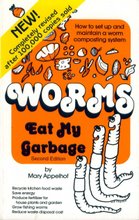
Sunday, 3 June 2007
Brockley permaculture update

Friday, 1 June 2007
Friday, 25 May 2007
Moving down under...
Added today: Potato peelings, kiwi fruit skins, apple skin, parsnip, lettuce, radish stalks
Saturday, 19 May 2007
Tuesday, 8 May 2007
Composting bin update

It looks as though I have my first funghi in the bin aswell!
 Added: stalks from home grown mixed leaf lettuce
Added: stalks from home grown mixed leaf lettuce
The vermicomposting cycle is complete!


Monday, 7 May 2007
More food!

Saturday, 5 May 2007
Brockley permaculture update...we have food!



Thursday, 3 May 2007
Extra-curricular permaculture

Tuesday, 24 April 2007
Brockley permaculture update...

Tuesday, 10 April 2007
Monday, 2 April 2007
Vermiculture cycle progress update
Monday, 26 March 2007
new arrivals!

Sunday, 11 March 2007
Soil experiments


Monday, 5 March 2007
Wednesday, 28 February 2007
Sunday, 25 February 2007

Monday, 19 February 2007
Harvest time!
A head count or rather weight estimate of the worms revealed that the population has more than doubled to over a 1000 worms now. Whilst sorting the vermicompost and worms I came across many eggs which I saved and also quite a few centipedes, needless to say they didn't survive the cull.

the last image before harvesting
 sorting through the worm bin
sorting through the worm bin
 I found lots of these stalks which are from the end of bananas and found that the younger worms absolutely love them. i had assumed that they wouldn't like them too much because they're so hard when they go in the worm bin but when they're like this you can understand why they love them because of all the fibrous material contained within it.
I found lots of these stalks which are from the end of bananas and found that the younger worms absolutely love them. i had assumed that they wouldn't like them too much because they're so hard when they go in the worm bin but when they're like this you can understand why they love them because of all the fibrous material contained within it.
I decided to re-organise the worm bin so that they're was hardly any soil in it and that it was comprised of newspaper and cardboarding shreddings and food. This way I will get a more accurate calculation of just how much vermicompost they can produce. The vermicompost from the worm bin that has been harvested will now be used to grow more food (see next update!)
Thursday, 8 February 2007
Sunday, 4 February 2007
Thursday, 18 January 2007
Friday, 12 January 2007
Terrorists strike the worm bin?
'Millipedes are detritivores, earth's natural recyclers. They feed on plants and animals that have died, which recycles nutrients back into the soil much faster than waiting for the plant or animal to decompose naturally.'
However whilst millipedes appear to be a good thing centipedes are not; they like eating worms and it appears that they don't take to kindly to human contact either:
'Centipedes bite. They have strong jaws that inject venom into their victims. A centipede bite is a very painful and unforgettable experience. The affected area will become increasingly painful, inflamed, and will secrete pus. You'll be sorry if you attempt to touch or handle this creature.'
If I do have centipedes then should I risk my precious hands or let nature take it's cause?!
Worryingly as the image shows below it looks like part of a worm has had an unfortunate incident resulting in loss of (part of) body. Initial investigations by the Worm Police Department (WPD) suggest that there are two possible suspects; firstly a gang of (potentially) centipedes roaming the worm bin set upon the poor worm while he/she wasn't looking, or secondly human intervention at feeding time could have resulted in 'accidental limb severing'. The investigation continues.


Waste added today: it was all a bit mushy and smelly but i think there were probably potato peelings, onion skins, apple cores, teabags and lettuce leaves in there.
Tuesday, 9 January 2007
Sunday, 7 January 2007


 Added today: potato, carrot, onion peelings, teabags
Added today: potato, carrot, onion peelings, teabags
Saturday, 6 January 2007
All is well...
Food added: Carrot, potato, apple peelings, teabags
Friday, 5 January 2007
2007: The year of free worm love?

FACT: In one year two mature worms can produce 1,500 worms per year in ideal conditions
A new year, a new approach...

Organic waste added: green beans, onion skins, banana skins, lettuce, potato peelings, normal teabags, roasehip infusion teabags, nettle tea leaves, carrot peelings, crushed egg shells.
Whilst carrying out the soil removal I came across many new members of the bin and some which could have been no more than a week old (see images below) and see the video!
Sunday, 17 December 2006
Christmas cheer is here!
Today the worms got a special Christmas treat with the addition of some paper which had been shredded just the way they love it, all long and thin so they can wrap themselves up in it to their hearts content.


Monday, 11 December 2006
The first newborn!
Seen: a very young worm. Probably born in the last couple of weeks; about 20-30mm in length.
 exclusive new shots of the first sighting of new eisenia fetida!
exclusive new shots of the first sighting of new eisenia fetida!
Maintenance: As mentioned previously the bottom section of the box had filled up with earth and consequently some worms had made their way down to the great abyss alas a rescue/maintenance operation was in need. I took the box apart and cleaned and reorganised, spreading the new food added in an evenly spread layer.
 vermicomposter maintenance
vermicomposter maintenance
Wednesday, 6 December 2006
Nature expands further...
Added: potato peelings, broccoli offcuts, teabags, onion skins
Seen: baby centipede!

Thursday, 30 November 2006
Feast!
Monday, 27 November 2006
Vermicomposter in good health...

Saturday, 25 November 2006
Worm lovin'
Thursday, 23 November 2006
Good worm housekeeping...

















